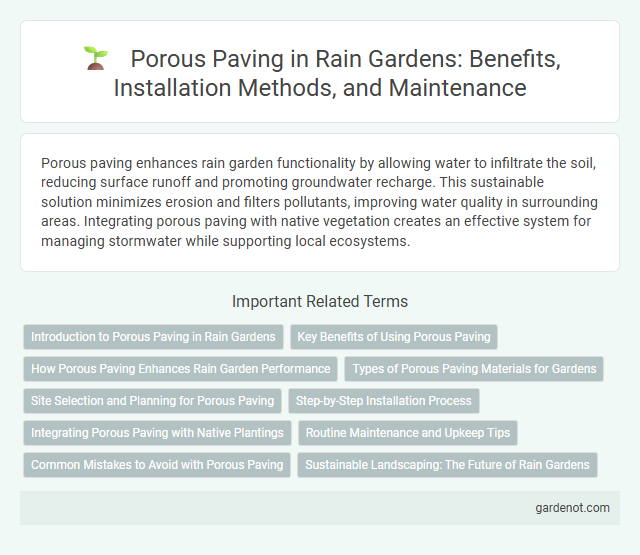Porous paving enhances rain garden functionality by allowing water to infiltrate the soil, reducing surface runoff and promoting groundwater recharge. This sustainable solution minimizes erosion and filters pollutants, improving water quality in surrounding areas. Integrating porous paving with native vegetation creates an effective system for managing stormwater while supporting local ecosystems.
Introduction to Porous Paving in Rain Gardens
Porous paving in rain gardens allows water to infiltrate through surfaces such as permeable concrete, porous asphalt, or interlocking pavers, reducing stormwater runoff and promoting groundwater recharge. This sustainable landscaping technique enhances rain garden efficiency by managing pollutant filtration and minimizing erosion. Porous paving also supports urban water management goals by controlling surface water on driveways, walkways, and patios.
Key Benefits of Using Porous Paving
Porous paving enhances rain gardens by allowing stormwater to infiltrate directly into the soil, reducing runoff and minimizing erosion. This permeable surface improves groundwater recharge while filtering pollutants, promoting healthier ecosystems. Key benefits include improved water management, decreased flood risk, and increased durability compared to traditional paving materials.
How Porous Paving Enhances Rain Garden Performance
Porous paving significantly enhances rain garden performance by allowing water to infiltrate through surfaces, reducing stormwater runoff and promoting groundwater recharge. This permeable material filters pollutants and sediments, improving water quality before it reaches the rain garden. Integrating porous paving with a rain garden maximizes stormwater management efficiency and supports sustainable landscaping.
Types of Porous Paving Materials for Gardens
Porous paving materials suitable for rain gardens include permeable concrete, porous asphalt, and interlocking pavers, each designed to allow water infiltration while providing structural durability. Gravel and crushed stone provide natural drainage and support plant growth by enhancing soil aeration in garden landscapes. Permeable materials reduce runoff, promote groundwater recharge, and minimize erosion in sustainable garden designs.
Site Selection and Planning for Porous Paving
Site selection for porous paving requires evaluating soil permeability and drainage patterns to ensure optimal water infiltration and prevent surface runoff. Planning should include assessing existing vegetation, slope gradient, and surrounding infrastructure to integrate the porous paving effectively within the rain garden design. Proper consideration of load-bearing requirements and anticipated water volume enhances the durability and functionality of porous surfaces in managing stormwater.
Step-by-Step Installation Process
Porous paving installation begins with site assessment and excavation to a depth of 8-12 inches, allowing for a base layer of crushed stone that ensures optimal drainage. A geotextile fabric is then laid to prevent soil migration, followed by evenly spreading and compacting aggregate layers to create a stable foundation. Finally, porous paving materials such as permeable concrete, pavers, or asphalt are installed, ensuring surface permeability for effective stormwater infiltration within the rain garden system.
Integrating Porous Paving with Native Plantings
Porous paving reduces stormwater runoff by allowing water to infiltrate through surfaces directly into the soil, enhancing rain garden function. Integrating porous paving with native plantings supports soil health and biodiversity while improving water absorption and filtration. This combination creates a sustainable, low-maintenance landscape that mitigates erosion and replenishes groundwater.
Routine Maintenance and Upkeep Tips
Porous paving requires routine maintenance to preserve its permeability and prevent clogging. Regularly removing debris, such as leaves and sediment, helps maintain water infiltration rates and promotes healthy rain garden function. Seasonal inspections and periodic vacuum sweeping or pressure washing are recommended to ensure long-term durability and optimal stormwater management.
Common Mistakes to Avoid with Porous Paving
Common mistakes to avoid with porous paving include improper substrate preparation, which can lead to poor drainage and surface pooling. Using incorrect or compacted base material reduces permeability, negating the benefits of the porous design. Failure to perform regular maintenance, such as cleaning debris from the surface, causes clogging and decreases water infiltration efficiency.
Sustainable Landscaping: The Future of Rain Gardens
Porous paving enhances sustainable landscaping by allowing rainwater to infiltrate the soil, reducing runoff and promoting groundwater recharge in rain gardens. This eco-friendly solution supports stormwater management, decreases pollution, and helps maintain healthy urban ecosystems. Integrating porous paving in rain garden design is essential for future-proofing green infrastructure and advancing climate resilience.
Porous paving Infographic

 gardenot.com
gardenot.com